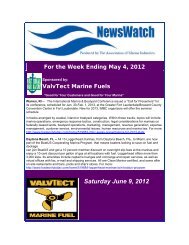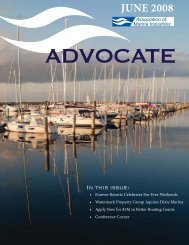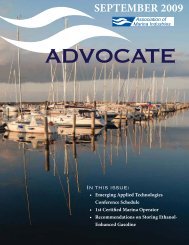Download a copy of AMI's Clean Marina best management practices ...
Download a copy of AMI's Clean Marina best management practices ...
Download a copy of AMI's Clean Marina best management practices ...
You also want an ePaper? Increase the reach of your titles
YUMPU automatically turns print PDFs into web optimized ePapers that Google loves.
Hazardous Waste<br />
Hazardous Waste Generators are those companies that produce greater than 100 kilograms (about 220 pounds<br />
or 30 gallons) <strong>of</strong> hazardous waste during one calendar month or who store more than 100 kilograms at any one<br />
time. These businesses must register with EPA.<br />
How Do You Know if a Substance is Hazardous?<br />
All waste generators must determine whether or not their refuse is hazardous. The waste is hazardous if it<br />
exhibits one or more <strong>of</strong> the characteristics <strong>of</strong> hazardous materials: ignitability, corrosivity, reactivity, or toxicity.<br />
A generator may either have the waste tested in an industrial laboratory to determine if it exhibits a hazardous<br />
characteristic or use knowledge <strong>of</strong> the waste, i.e., first hand experience or information gathering from a Material<br />
Safety Data Sheet.<br />
Recycle Liquid Wastes<br />
• Do not allow patrons to pour gasoline, solvents, paints, varnishes, or pesticides into the oil or antifreeze<br />
recycling containers. The introduction <strong>of</strong> these materials creates a hazardous waste, where the whole<br />
tank must be disposed <strong>of</strong> as hazardous waste: a very expensive undertaking.<br />
• Provide separate containers to collect oil and antifreeze. Also, collect solvents from your boatyard<br />
according to hazardous waste regulations.<br />
• Surround tanks with impervious, secondary containment that is capable <strong>of</strong> holding 110 percent <strong>of</strong> the<br />
volume <strong>of</strong> each tank.<br />
• Try to shelter tanks from wind and rain.<br />
• Attach funnels to tanks to reduce chances <strong>of</strong> spills. Funnels should be large enough to drain portable<br />
containers and oil filters. Use funnels with locking lids that screw into the bungs <strong>of</strong> 55-gallon drums.<br />
• Post signs indicating what may and may not be placed in each tank.<br />
• Check with your recycler to learn what materials may be mixed. In some cases, engine oil, transmission<br />
fluid, hydraulic fluid, and gear oil may all be placed in a waste oil container. Some haulers will also take<br />
diesel and kerosene. Ethylene glycol and propylene glycol antifreeze are <strong>of</strong>ten collected in the<br />
same used antifreeze tank.<br />
• Consider locking intakes to oil and antifreeze recycling containers to prevent contamination. Instruct<br />
your patrons to get the key from the appropriate staff person or to leave their oil or antifreeze next to the<br />
collection tank. Assign a staff member to inspect the collection site daily for any material that may have<br />
been dropped <strong>of</strong>f.<br />
• Investigate waste haulers to insure that they actually recycle the collected material.<br />
• Maintain shipping manifests for solvents and other hazardous wastes for a minimum <strong>of</strong> 3 years<br />
(manifests are not required for used oil and antifreeze that is being recycled).<br />
Management-marinas<br />
• Minimize the use <strong>of</strong> hazardous products to reduce health and safety risks to your staff, tenants and con<br />
tractors; lower disposal costs; decrease liability; and limit chances that you will be liable for costly<br />
clean-up <strong>of</strong> inappropriately disposed material.<br />
• Do not store large amounts <strong>of</strong> hazardous materials. Purchase these materials in quantities that you will<br />
use up quickly.<br />
• Establish a first-in first-out policy to reduce storage time. Dispose <strong>of</strong> excess material every 6 months.<br />
• Label wastes properly, especially when different types <strong>of</strong> wastes are stored in the same area.<br />
• Avoid using, to the greatest extent possible, products that are corrosive, reactive, toxic, or ignitable.<br />
• Adopt an inventory control plan to minimize the amount <strong>of</strong> hazardous material you purchase, store,<br />
and dispose.<br />
11












